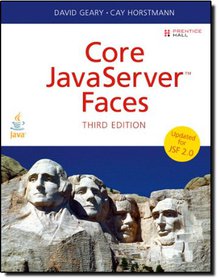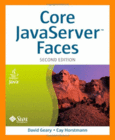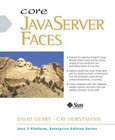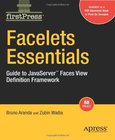Core JavaServer Faces
3rd Edition

Book Details:
| Publisher: | Prentice Hall |
| Series: | Prentice Hall |
| Author: | David M. Geary |
| Edition: | 3 |
| ISBN-10: | 0137012896 |
| ISBN-13: | 9780137012893 |
| Pages: | 672 |
| Published: | Jun 06 2010 |
| Posted: | Nov 19 2014 |
| Language: | English |
| Book format: | |
| Book size: | 37.56 MB |
Book Description:
JavaServer Faces (JSF) is the standard Java EE technology for building web user interfaces. It provides a powerful framework for developing server-side applications, allowing you to cleanly separate visual presentation and application logic. JSF 2.0 is a major upgrade, which not only adds many useful features but also greatly simplifies the programming model by using annotations and 'convention over configuration' for common tasks. To help you quickly tap into the power of JSF 2.0, the third edition of Core JavaServer Faces has been completely updated to make optimum use of all the new features. The book includes Three totally new chapters on using Facelets tags for templating, building composite components, and developing Ajax applications Guidance on building robust applications with minimal hand coding and maximum productivitywithout requiring any knowledge of servlets or other low-level 'plumbing' A complete explanation of the basic building blocksfrom using standard JSF tags, to working with data tables, and converting and validating input Coverage of advanced tasks, such as event handling, extending the JSF framework, and connecting to external services Solutions to a variety of common challenges, including notes on debugging and troubleshooting, in addition to implementation details and working code for features that are missing from JSF Proven solutions, hints, tips, and 'how-tos' show you how to use JSF effectively in your development projects Core JavaServer Faces, Third Edition, provides everything you need to master the powerful and time-saving features of JSF 2.0 and is the perfect guide for programmers developing Java EE 6 web apps on Glassfish or another Java EE 6-compliant application servers, as well as servlet runners such as Tomcat 6.
Download Link:
Related Books:
Core JavaServer Faces
2nd Edition
JavaServer Faces (JSF) is quickly emerging as the leading solution for rapid user interface development in Java-based server-side applications. Now, Core JavaServer Facesthe #1 guide to JSFhas been thoroughly updated in this second edition, covering the latest feature enhancements, the powerful Ajax development techniques, and open source innovations that make JSF even more valuable. Authors David Geary and Cay Horstmann delve into all facets of JSF 1.2 development, offering systematic best practices for building robust applications, minimizing handcoding, and maximizing productivity. Drawing on unsurpassed insider knowledge of the Java platform, they ...
Core JavaServer Faces
JavaServer Faces is a Web application framework -- similar to Jakarta Struts -- that gives application developers access to custom components that facilitate the creation of rich user interfaces. JSF also provides Integrated Development Environment (IDE) vendors with a standard upon which to base their IDEs. In the Core tradition, this new book aims to be THE tutorial and reference for experienced programmers who need to learn this exciting new technology. Although J2EE is still the most popular platform for developing Web applications, Microsoft's .NET has gained market share over the past two years. J2EE is arguably more powerful, but .NET, is generally regarded as easier to use. J2EE currently lacks: a rich component model that makes it easy to de...
Facelets Essentials
Guide to JavaServer Faces View Definition Framework
Facelets is a templating language developed from the ground up with JavaServer Faces in mind. Created in response to the many concerns involving JavaServer Pages (JSP)when building JavaServer Faces (JSF)views, Facelets steps outside of the JSP specification and provides a highly performant, JSFcentric view technology. Facelets' top properties, templating, reuse, and ease of development, allow it to help making JSF a technology suitable for largescale projects. One of the first things a developer using Facelets finds is that it immediately leads to a reduction inuser interfacecode. Facelets Essentials, the first book on Facelets, introduces you to its importance, architecture, and relationship to JSF and the Apache MyFaces web framework. Learn to crea...
2007 - 2021 © eBooks-IT.org



